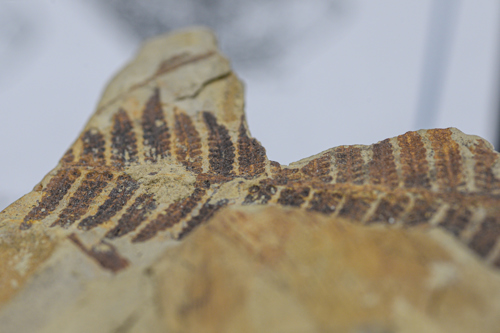Prehistory of the USI Trails

300 million years ago, this area known as the Illinois Basin, was close to sea level, and where USI sits today would have been a shallow, warm sea. We know that the basin was close to sea level from the marine fossils found in the regions’ sandstone. What wasn't covered by the sea was a marshy area that contained very primitive trees and bushes: Cordites, an early relative of conifers; Calamites, a bushy horsetail; Medullosa, a seed fern (a plant with seeds and fern-like leaves); Psaronius, a tree fern; and Paralycopodites and Lepidophloios, lycopsids (scaly, pole-like trees with cones). Lepidophloios could grow to 40 m (132 ft), but most of today’s lycopsids, known as quillworts and club mosses, grow only a few centimeters high.
This was known as the Carboniferous Period, due to the amount of coal strata that formed globally. Additionally, when a dead plant or animal decays, microbes decompose it and combine its carbon with oxygen in the air to produce carbon dioxide, a greenhouse gas.
After millions of years of heat and pressure, the buried remains of these giant plants were transformed into the large reserves of coal that we rely on today to supply so much of our energy. When we burn fossil fuels such as coal, oil and natural gas, we release carbon dioxide from the dead plants and animals that were buried millions of years ago.
Also known as the Age of Amphibians, when the amphibians became dominant land vertebrates and diversified into many forms including lizard-like, snake-like and crocodile-like. Between the swamps, the forests and the decay, the region was very oxygen rich, which gave rise to giant insects. Southern Indiana was certainly much different place than it is now!
USI's Sandstone Cliffs and Creek beds
Much of USI sits on sedimentary rock called Inglefield Sandstone. The cliffs and creek beds are lined with the gritty, sandy material. Sandstone is formed from a mixture of sedimentation consisting of coarse sand and minerals like mica, quartz and feldspar. You can also find traces of hematite, ilmenite and iron oxide. Hold a piece of sandstone in the sun and turn it back and forth and you'll see the minerals sparkle.
Sandstone is formed over millions of years of being compressed and compacted due to pressure. When you look at sandstone on the USI trails, you can see the ripples and holes from water, wind and plant erosion.

Crinoids on South Trail
You can find fossils like these in the creek beds



